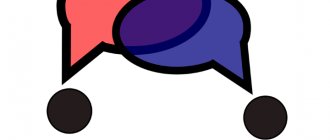- KtoNaNovenkogo
- FAQ
- Are you here
September 17, 2020
- What does it all mean
- Verbally is...
- Forms of verbal communication
- Nonverbal communication is...
- Differences between these types
Hello, dear readers of the KtoNaNovenkogo.ru blog. Communication through speech became possible after the evolution of animals into humans.
Ancient people used sound signals to warn of danger or convey important information that a bush with edible berries had grown nearby.
Today, verbal communication is something that every person cannot do without. Starting from morning coffee over instant messengers to conversations at work with colleagues about the boss’s new relationship.
Verbal and non-verbal communication - what is it?
Verbal - This word comes from the Latin "verbalis", which means verbally . Those. communication in this case occurs through words.
There are three types of verbal communication:
- Speech is communication through words (dialogues, monologues).
- Written communication - by hand, printing on a computer, SMS, etc.
- Internal - your internal dialogue (thought formation).
Nonverbal - other types of communication other than verbal. What could it be:
- Gestures, facial expressions and postures - all this tells us a lot if you know how to read them.
- Visual - scanning a person in the first seconds when you see him: determining gender, age, assessing appearance and facial expression.
- Acoustic nonverbal perception is an assessment of the voice (its rhythm, timbre, volume, brightness, pauses, cough, filler words).
- Tactile non-verbal communication - touching (has a very significant meaning).
- Some smells attract you, while others repel you.
- Mobility - enlivens perception, but if there is too much mobility, fatigue occurs.
- Boundaries of personal space - crossing them takes a person out of his comfort zone or, conversely, brings him closer together.
Creation of radio as a means of transmitting information. History of wireless communication basics
American Mahlon Loomis presented the first prototype of a wireless communication line in 1868, its length was about 22 km. It was he who believed that the possibility of creating international wireless communications was real, provided that humanity could learn to use electricity from the atmosphere. Loomis spoke about radio waves, the existence of which was confirmed by Heinrich Hertz only 19 years later.
Loomis's ideas were brought to life by A. S. Popov, who developed the world's first radio, presented to the scientific minds of St. Petersburg University on April 25, 1895 (May 7, old style). And on May 24, 1896, the world’s first text radiogram was transmitted, consisting of two words “Heinrich Hertz”. This was Popov’s tribute to the great discovery of the German scientist. By the way, it was Popov who proposed the idea of using wireless communications on ships to transmit operational messages and distress signals.
The end of the 19th century became the third powerful wave of the information revolution, because it became possible to transmit information over any distance thanks to the telegraph, telephone and radio.
Verbally - this is our difference from the other living world
Words that are composed into speech are the unit of our communication with you. We use them both in oral pronunciation and in writing. Or typing (typing on the keyboard), if we talk about realities that are closer to us. Such communication is divided depending on who plays what role: speaking - listening, writing - reading.
In order to maintain verbal communication at a high level, you need to develop its components. This is, first of all, vocabulary (what is it?). Reading books, listening to vocabulary, talking with intellectually developed people - all this significantly helps to replenish and expand your vocabulary.
When communicating in writing, it is very important to know the rules of punctuation in order to present information correctly. Often, by placing periods and commas incorrectly, you can distort the meaning or emphasize something wrong. We all remember the cartoon where you had to put the punctuation mark in the right way and save your life: “Execution cannot be pardoned.”
Speech and written communication solves several problems at once:
- Communicative – ensures interaction between people in its large-scale manifestations.
- Cognitive – a person gains knowledge and new information.
- Cumulative – displaying accumulated knowledge (writing notes, books).
- Emotional - you can express your attitude to the world, feelings using words.
- Ethnic – unification of the populations of different countries (according to the language used).
A telephone as the result of an unusual experiment
Next comes the emergence of the telephone as a new means of transmitting information. Its history begins in 1837, when C. Page, an American scientist, designed the “grumbling wire” - the prototype of the future telephone. A more approximate version was created in 1860 by a school physics teacher from Germany, Philipp Reis. But his device could only transmit distorted individual sounds. In Reis's homeland, the invention was not appreciated, and he left for the States, where he was arrested on charges of quackery, because the Americans were confident that it was impossible to transmit voice over wires. But the future creator of the first real telephone, A. G. Bell, a teacher at a school for the deaf and dumb, became familiar with Reis’s work. Based on it, he wanted to create a device that would turn sounds into light signals in order to teach deaf children to speak. As a result, completely by accident, he created a telephone and patented it on February 14, 1876. According to Bell himself, he was able to create such a device only because he was completely ignorant of the laws of electrical engineering. The Bell tube, the prototype of the apparatus familiar to us, was created in 1878.
Forms of verbal communication and barriers are not his way
When communicating verbally, we can use different forms and styles in order to convey certain information in a specific context and color. This can be clearly seen in the styles that are used in literature:
- Journalistic - the main goal of such a speech is to convey to people the idea, the essence of what happened.
- Scientific – distinguished by logic and clear statements using terminology and complex concepts.
- Official business is the dry language of laws, where everything is precise and without any epithets.
- Artistic - here it is possible to combine any words and word forms, jargons and dialect (dialectisms), speech is filled with unimaginable images and colors.
- Conversational - characterizes both individual dialogues in works and our communication with you when we meet an acquaintance.
Speech interaction can be divided according to the number of people who take part in it:
- Monologue (one person): speaking - at meetings in front of someone or reciting a poem in front of the class;
- report - important information, usually supported by numbers;
- report - similar to a report, but provides more extensive information and description;
- lecture – presentation of useful information to the audience.
- Dialogue (two or more people):
- ordinary conversation - exchange of greetings and thoughts;
- discussion – discussion of a topic where the interlocutors represent different points of view;
- dispute – here, too, there are two positions between which the resulting conflict needs to be resolved;
- a debate is a discussion within the framework of science;
- interview - a conversation during which the employer thinks about whether to hire a person.
Despite the fact that we communicate in the same language, various barriers to verbal communication :
- For example, phonetic. The interlocutor may have a speech impediment, unpleasant diction, choose an unusual intonation, sprinkle words with parasites, etc...
- Semantic interference arises between people from different countries, with different mentalities, or even when raising children in different families.
- A logical barrier is if the interlocutors have different types of thinking, levels of development and intelligence.
- A stylistic barrier is that the interlocutor incorrectly builds a chain of verbal communication to convey information. First we need to attract attention to what we want to say, to interest. Then lay out the basic information; answer questions that your opponent may have. After this, give him time to think about it so that he can draw conclusions or make a decision.
Postal message
Mail as a means of communication began to be used even before the invention of writing. Messengers initially conveyed oral messages. However, with the advent of the opportunity to write a message, this type of communication has become even more in demand. The messengers were initially on foot, later on horseback. In developed ancient civilizations there was a well-established postal service based on the relay race principle. The first postal services originated in Ancient Egypt and Mesopotamia. They were mainly used for military purposes. The Egyptian postal system was one of the first and highly developed; it was the Egyptians who first began to use carrier pigeons. Subsequently, mail began to spread to other civilizations.
Nonverbal communication is something we inherited.
Nonverbal communication is body language (like the rest of the animal kingdom). Facial expressions, gestures, postures, touches . As well as visual and acoustic perception, smells, distance and movement of communicating objects - everything is exactly like that of animals.
All this can carry a lot of information, so you shouldn’t neglect this format in order to make the right impression on people (pleasant perfume and appearance, voice and manner of movement).
It is important not only to interpret these signals correctly, but also to send them correctly to the interlocutor. Nonverbal communication serves not only as a complement to conversation using words, but in some situations it can completely replace it.
There are gestures that indicate greeting or farewell. Communicative expressions also include expressions of misunderstanding, increased attention, denial or agreement. There are also modal ones - they show a person’s attitude to what another person is telling him. Facial expressions can show both trust and its complete absence.
Accents are something that can be successfully placed using non-verbal means, if this cannot be done fully with intonation. After all, you often need to indicate to your interlocutor what you really consider important, where to focus your attention. So that secondary information does not take a lot of time to analyze and make a decision.
Sadness, anger, joy, sadness, satisfaction - these are things that can best be emphasized through verbal means (you can even fully show these feelings with your gestures and facial expressions). Therefore, if you are attentive to your interlocutor, you can read his state without words (empaths, whom we have already talked about, are famous for this).
Don't forget about poses and posture. It is the form and behavior of the body that provides just as much information. Can be dominant or submissive, calm or tense, constrained or completely open.
The distance between interlocutors can also be analyzed. The closer they are, the more they trust each other. If it’s really far away, is it worth talking about at least a small presence?
Development of the telegraph
The history of the development of communications quite naturally begins with the telegraph. The first version of telegraphy, which was invented by Democritus and Cleoxenus (ancient Greek philosophers), was the torch telegraphy, which was mentioned above. However, it did not take root, and attempts to invent fundamentally new types of telegraphy were made by various scientists from the beginning of the 17th century.
In 1793, the optical telegraph was invented, which was a fundamentally new concept that did not operate on the basis of light. However, he needed new ways to transmit large amounts of information. And only thanks to the discovery of electromagnetic waves, such a type of long-distance communication as the electric telegraph appeared. Later, electrostatic and electrochemical devices were invented.
The switch-type electromagnetic telegraph appeared in 1832 thanks to the works of the Russian scientist P. L. Schilling, and the electromechanical one was patented in 1840 by Samuel Morse, who invented a special telegraph code. In 1939, B. S. Jacobi invented the first writing machine, and in 1850, the first direct-printing telegraph machine.
Recent history of data communications
Paging, cellular communications, fiber optic communication lines - all these are steps towards creating a global communications network. The creation of computers was an important but intermediate stage. It was microprocessor systems that revolutionized the way information is transmitted. Digital communication has brought about changes that have made information a key element of modern society. The network has conquered the world and become an integral part of all its spheres: politics, education, art, industry. Geographic boundaries turned out to be blurred, because the network instantly connects people at opposite poles of the planet in a matter of seconds. This is a giant step in the development of data communications.










